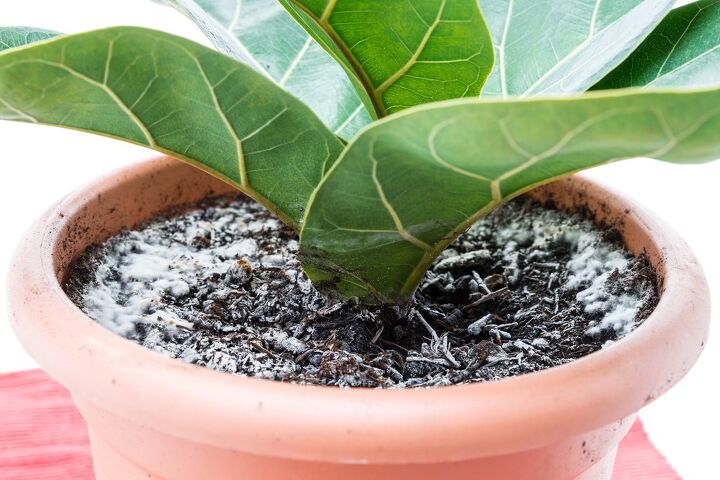Is Moldy Soil Bad? How To Fix It

Spring is the most exciting time of year for anybody with a green thumb. The excitement and possibilities of picking out plants and planting seeds are incredible. However, it can be disconcerting when you discover moldy soil in your garden or potted plants. So, is moldy soil bad?
Moldy soil isn’t always bad, but in some cases, it can remove nutrients from the plant. Plants rely on nutrients like potassium, nitrogen, and phosphorous that you can find in soil. Mold robs the plant of these nutrients, which can hinder growth and weaken the plant. Ideally, you should remove the top layer of moldy soil and treat it with fungicide.
You can prevent mold from growing in the soil if you only water your plants enough to saturate the top layer. Oversaturation not only causes moldy conditions, but over time, it can also kill your plants. It’s a good idea to stir and poke holes in the soil to increase aeration. Lack of oxygen is a common condition that leads to moldy soil. Follow along as we explore everything you must know about moldy soil and how to treat it.
Is It Okay To Use Moldy Potting Soil?
It is okay to use moldy potting soil, but it’s inadvisable and doesn’t yield great results. Some mold may simply be a sign that the soil is full of a lot of organisms, and that’s not always bad. However, excessive mold may strip the soil of valuable nutrients, like potassium, nitrogen, and phosphorous.
These nutrients enrich your plants and help them grow to their full potential. Your plants become vulnerable to the elements if they don’t have these valuable nutrients. That said, a little bit of mold shouldn’t be a problem, but you should simply get rid of it if the soil is too moldy.
How Does Potting Soil Get Moldy?
Overwatering is the most common reason why potting soil gets moldy. Many plants only require 1” of water per week, but it depends on the type of plant and the climate. Oversaturated soil takes longer to drain, and it will stay wet for hours or even days.
Moisture control is essential to mold prevention, according to the EPA. Soil is more likely to become moldy if it’s consistently moist and in the shade. Mold loves darkness and moisture, as those are the perfect growth conditions.
Move your oversaturated potted plant into the sun if you accidentally overwater it. This should help dry the soil, so it doesn’t sit wet for too long and become moldy. A lack of aeration can also make your soil moldy. Try not to pack the soil too tightly or it won’t get enough oxygen, and it may get moldy.
How To Fix Moldy Soil
Luckily, most of the time it’s easy to fix moldy soil in houseplants and your potted outdoor plants. However, it may require a little patience and troubleshooting, as you may have to try a few methods, such as:
1. Manually Remove The Mold
Is the mold only on top of the soil? If so, then you’re in luck. This is the easiest circumstance to fix, and you can simply dig the mold off the top. You can either use your hands or a trowel to scoop the moldy soil into a waste bag.
Stir up the soil after you remove the moldy layer to make sure there isn’t any mold left. Next, replace the moldy soil with fresh soil. Try not to pack it down too tight, or else you may create moldy conditions again.
2. Treat The Soil With Fungicide
If you don’t catch the mold early enough, it may spread throughout the soil. You can either repot the plant entirely or treat the soil with a fungicide if that happens. Brands like Heritage G and Simple Green D produce powerful fungicides.
ollow the directions on the container before you treat the soil with fungicide. Generally, you must mix the fungicide with water and spray the soil to treat it for mold. Otherwise, you may simply have to scatter the fungicide in the soil to kill the mold.
Repeat the process as many times as the label on the container recommends. This works to both kill and prevent mold.
3. Treat The Soil With Household Items
You can fix your moldy soil with many household items that you can find in your kitchen. For example, baking soda, white vinegar, and even lemon juice can help kill mold. Your best bet is to start by mixing equal parts white vinegar and water in a spray bottle.
Spray the top layer of moldy soil with the mixture. Be careful you don’t spray the plant itself, as the vinegar can harm it. You can also mix baking soda with water and spray the moldy soil. Lemon juice should be your last resort before you try a store-bought fungicide.
The acidity of the lemon juice may be enough to kill the mold. That said, household remedies aren’t quite as effective as fungicides. However, they are better for the environment, so it’s worth a shot.
4. Transfer The Plant
In some cases, your moldy soil may be beyond saving. For example, the mold may have spread deep within the soil. That puts your plant at risk of losing vital nutrients that help with growth and root health. Be careful and make sure you leave the roots intact when you remove the plant from the pot or the ground.
Check the plant for mold before you replant it to make sure you don’t carry over any of the moldy soil. Otherwise, you may have another problem with moldy soil going forward. Water the plant right away, but only enough to moisten the top layer of soil.
Will Mold In Soil Go Away On Its Own?
Moldy soil won’t go away on its own, but you may not need to take drastic steps to eradicate it. In some cases, the mold spores will die if you simply let the plant dry out. This is somewhat risky, as you may harm the plant in the process if it’s too hot outside.
That’s why it’s recommended that you at least remove the top layer of moldy soil. Otherwise, mold can die within weeks or months if you change the surrounding conditions. For example, you can help naturally kill the mold if you put the plant in the sun and only water it sparingly.
Only water the plant once per week while the mold remains in the soil. Poke holes in the soil or stir it around to increase aeration to prevent more mold from growing and spreading. That said, it’s a better idea to use fungicide or simply repot the plant. This process takes a long time and your plant may die while you wait for the mold to go away.
Summing It Up
Moldy soil is bad in many cases as mold can remove nutrients like potassium from the soil. You can kill the mold in your soil with fungicides and household items like white vinegar and baking soda. Otherwise, simply scoop the moldy soil out and replace it. The best ways to prevent moldy soil are to boost soil drainage and let it get plenty of sunlight.
Related Guides:

Nick Durante is a professional writer with a primary focus on home improvement. When he is not writing about home improvement or taking on projects around the house, he likes to read and create art. He is always looking towards the newest trends in home improvement.
More by Nick Durante











![10 Best Zero Turn Mowers – [2022 Reviews & Ultimate Buyer's Guide]](https://cdn-fastly.upgradedhome.com/media/2023/07/31/9070522/10-best-zero-turn-mowers-2022-reviews-ultimate-buyer-s-guide.jpg?size=350x220)
![10 Best Electric Lawn Mowers - [2022 Reviews & Top Rated Models]](https://cdn-fastly.upgradedhome.com/media/2023/07/31/9070486/10-best-electric-lawn-mowers-2022-reviews-top-rated-models.jpg?size=350x220)














